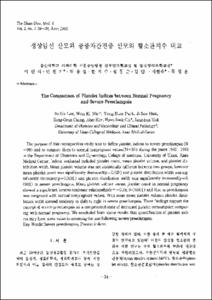폐쇄용적(Closing volume)증가가 일측성 폐질환자의 체위에 따른 동맥혈 산소분압 변동에 미치는 영향
- Alternative Title
- Effect of Closing Volume on Positional Hypoxia in Unilateral Lung Disease
- Abstract
- 일측성 폐질환자에서 건측 폐 하위시 환측 폐 하위시 보다 동맥혈 산소량이 높게 유지 된다는 것은 잘 알려져 있다. 이는 일반적으로 중력에 의해 하부폐에 환기, 관류가 더 많이 일어나기 때문이다. 한편 유아에서는 흉곽벽이 단단하지 못하고 폐에 대한 견인력이 약하여 흉막강 압력이 덜 음압인 것으로 알려져 있다. 따라서 유아에서는 하부폐의 기도폐쇄가 쉽게 일어나며 일측성 폐질환에서, 건측폐 하위시 보다 오히려 환측폐 하위시 동맥혈 산소분압이 더 높다고 알려져 있다. 이에 저자들은 일측성 폐질환을 가진 성인에서도 폐쇄용적이 증가된 경우 건측 폐를 상부로 하였을 때에 건측 폐를 하부로 하였을 때 보다 동맥혈 산소분압이 더 높을 수 있다고 가정하였다.
39명의 ?衢遍? 폐질환 환자를 대상으로 즉, 체위별, 정와위, 우와위에서 동맥혈 가스분석을 시 행하였으며 이중 18명의 환자에서 폐활량 측정법의 측정치 및 폐쇄용적을 측정비교하였다.
1. 건측 폐 하위시 동맥혈 산소분압이 높았던 군(A군)에서 건측 폐 하위 와위시 평균 Pao₂는 88.5±15.1mmHg, 환측 하위 와위시 평균 Pao₂는 78.6±13.3이었다.(P<0.001)
2. 한측 폐 하위시 동맥혈 산소분압이 높았던 군(B군)에서 건측 폐 하위 와위시 평균 Pao₂는 79.4±5.3, 환측 하위 와위시 평균 Pao₂는 87.9±6.2이었다.(P<0.001)
3. A군에서 평균 FVC는 78.2±14.8, FEV1은 61.5±21.3%, FEF25-75%는 57.9±23.4%이었고 B군에서는 평균 FVC는 63.7±28.6%, FEV1은 59.2±26.2%, FEF25-75%는 67.5±26.2% 이었다.
4. A군에서 CV은 87.8±13.6%, B군에서는 CV은 121±18.8%으로서 양군 사이에 유의한 차이가 있었다.(P<0.05).
이상의 결과로서 폐쇄용적이 증가한 환자에서 일측성 폐질환의 경우 동맥혈 산소분압이 환측 폐 하위시 건측 폐 하위시 보다 높을 수 있음을 관찰하였다.
In unilateral lung disease, it is well known that good lung dependent position has higher Pao₂than bad lung dependent lateral decubitus position. Usually the lung base is more perfused and more ventilated than the apex because of gravity and lung weight. But infants have the floppier chest wall than adults and the resting pleural pressure in infants is more positive than that of adult. In infants, peripheral airways on dependent lung regions may be easily closed and therefore infants have large closing volume. In fact, it is well known that infants have higher Pao₂at bad lung dependent position than at good lung dependent position in unilateral lung disease.
We assumed that in adult if closing volume is increased, bad lung dependent position could have higher Pao₂ than good lung dependent position.
In 39 patients with unilateral parenchymal lung disease, we analysed changes of blood gas status in various body position(supine, right and left decubitus). Spirometry and closing volume were measured in 18 patients.
The results are as follows.
1) In patients with higher Pao₂ at good lung dependent position, mean Pao₂was 88.5±15.1 mmHg at good lung dependent position and 78.6±13.3 mmHg at bad lung dependent position(P<0.001).
2) In patients with higher Pao₂at bad lung dependent position, mean Pao₂was 79.4±5.3 mmHg at good lung dependent position and 87.9±6.2 mmHg at bad lung dependent position(P<0.01).
3) Closing volumes were significantly different between patients with higher Pao₂at good lung dependent position and patients with higher Pao₂ at bad lung dependent position(87.8%±13.6% vs, 121±18.8%, p<0.05).
From these results, we observed that patients with increased closing volume could have higher Pao₂at bad lung dependent position than at good lung dependent position.
In unilateral lung disease, it is well known that good lung dependent position has higher Pao₂than bad lung dependent lateral decubitus position. Usually the lung base is more perfused and more ventilated than the apex because of gravity and lung weight. But infants have the floppier chest wall than adults and the resting pleural pressure in infants is more positive than that of adult. In infants, peripheral airways on dependent lung regions may be easily closed and therefore infants have large closing volume. In fact, it is well known that infants have higher Pao₂at bad lung dependent position than at good lung dependent position in unilateral lung disease.
We assumed that in adult if closing volume is increased, bad lung dependent position could have higher Pao₂ than good lung dependent position.
In 39 patients with unilateral parenchymal lung disease, we analysed changes of blood gas status in various body position(supine, right and left decubitus). Spirometry and closing volume were measured in 18 patients.
The results are as follows.
1) In patients with higher Pao₂ at good lung dependent position, mean Pao₂was 88.5±15.1 mmHg at good lung dependent position and 78.6±13.3 mmHg at bad lung dependent position(P<0.001).
2) In patients with higher Pao₂at bad lung dependent position, mean Pao₂was 79.4±5.3 mmHg at good lung dependent position and 87.9±6.2 mmHg at bad lung dependent position(P<0.01).
3) Closing volumes were significantly different between patients with higher Pao₂at good lung dependent position and patients with higher Pao₂ at bad lung dependent position(87.8%±13.6% vs, 121±18.8%, p<0.05).
From these results, we observed that patients with increased closing volume could have higher Pao₂at bad lung dependent position than at good lung dependent position.
- Issued Date
- 1992
- Type
- Research Laboratory
- Alternative Author(s)
- Kim, Yong Tae; Lim, Chae Man; Chin, Jae Yong; Koh, Younsuck; Kim, Woo Sung; Kim, Won Dong
- Publisher
- 울산의대학술지
- Language
- kor
- Rights
- 울산대학교 저작물은 저작권에 의해 보호받습니다.
- Citation Volume
- 1
- Citation Number
- 1
- Citation Start Page
- 70
- Citation End Page
- 76
- Appears in Collections:
- Research Laboratory > The ULSAN university medical journal
- 파일 목록
-
-
Download
 000002024746.pdf
기타 데이터 / 213.12 kB / Adobe PDF
000002024746.pdf
기타 데이터 / 213.12 kB / Adobe PDF
-
Items in Repository are protected by copyright, with all rights reserved, unless otherwise indicated.